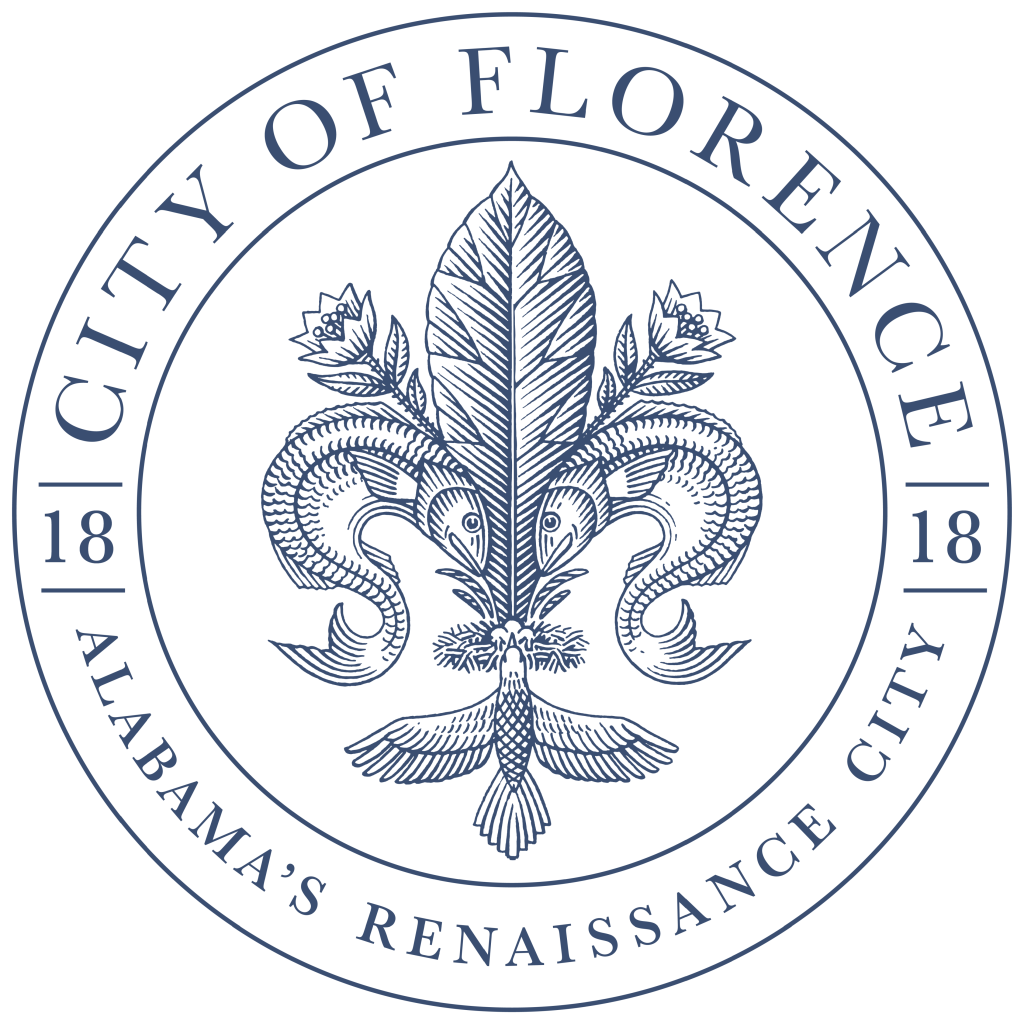Frequently Asked Questions
The City Engineering Department provides municipal engineering services to the City of Florence. Their responsibilities include planning, design, construction, and inspection of roadways, bridges, sanitary sewers, and drainage. They assist in preparing planning reviews and project designs of public works projects and answer public inquiries regarding rights-of way, public property lines, stormwater drainage, and sanitary sewerage.
The City Engineering Department prepares traffic and accident studies of city streets and performs field inspections of all elements of the City infrastructure. The department inspects commercial, industrial and residential subdivisions. The department also recommends maintenance practices for streets, highways, bridges, and other municipal improvements.
The department works closely with the Police and Electricity Departments on traffic related issues, with the Street Department on issues related to roadways, bridges and drainage, and with the Building and Planning Departments for new developments.
When a request is made for a speed cushion, a speed/traffic study is performed by the City Engineering Department. The vehicle volume, the 85th percentile speed, and the street characteristics are evaluated and compared against criteria established by the Traffic Committee. If the street meets the objective criteria for the installation of speed cushions, it is then submitted to the Traffic Committee for their review and approval. Once a determination is made as to whether or not a specific street meets the criteria, the individual making the request is notified of the results, and the decision of the Traffic Committee.
After speed cushions have been approved for a particular street, the individual that requested them is advised that a petition must be submitted to the City with 70% of the residents on the street agreeing to the installation. Once the petition is received and verified, installation of speed cushions can be scheduled.
Note: Traffic counts are performed over a 24-hour period. After a traffic count is completed, the City will not perform another study on the same street for a period of eighteen months.
In addition to the City Engineer, the Police Chief, Fire Chief, Emergency Management Director, Planning Director, and the Electricity Department Director of Engineering/Operations are all members.
Speed cushions are made of recycled rubber. They are about three inches high, and between 6 and 7 feet long as measured in the direction of travel and between 6 and 7 feet as measured perpendicular to the direction of travel. Typically, more than one cushion will be used at any given location. The number of cushions used will depend on the width of the street. There is a space or gap between each cushion. This space allows emergency vehicles, typically having a wider wheel base, to “straddle” the cushions with only a minimal delay. Speed bumps are traffic calming devices typically found in parking lots. They are higher than speed cushions and are typically less than one foot long in the direction of travel. Speed bumps are not used on public rights-of-way in Florence.
The 85th percentile speed is the speed criteria referred to in the Federal Highway Administration Manual on Uniform Traffic Control Devices. It is a measure frequently used by traffic engineers to describe the speed characteristics of a group of vehicles. This level is the speed at which 85% of the vehicles are traveling at or below.
No. The City of Florence only places standard signs on City Streets. Any sign placed must meet the criteria in the Federal Highway Administration Manual on Uniform Traffic Control Devices (MUTCD). “Children at Play” signs are not included as a standard sign in this manual. Studies have shown that signs placed in residential areas for the purpose of warning motorists of normal conditions, do not improve safety. These signs may give parents a false sense of security, since motorists frequently ignore them.
The City of Florence places signs in accordance with the MUTCD. This manual provides criteria based on traffic volumes and accident totals for the placement of stop signs. When a citizen makes a request for additional signage, a traffic study is performed and the results compared against the criteria outlined in this manual. If the criteria are met then these sign systems are placed.
As mentioned in the above discussion for “4-Way Stop” systems, the MUTCD provides criteria based on traffic volumes and accident totals for the placement of traffic signal systems. When a citizen requests a traffic signal system be installed, a traffic study is performed to determine if the criteria outlined in the MUTCD is satisfied. Before a signal system is installed there is a lengthy design and review process.
When the City Engineering Department receives a request for service related to a drainage problem, a determination is made as to whether the problem is routine or if it will require extensive work. Many drainage problems are routine in nature (i.e. stopped up catch basins and pipes). These types of problems are addressed as they are received.
There are other drainage related problems that require extensive work. These projects are prioritized on the City’s Drainage List. The prioritization is made based on the seriousness of the problem. After a specific request is evaluated the problem is assigned a grade from 1 to 7. The lower the grade the more serious the problem and the higher the project will be on the city’s drainage list.
Note: There are many drainage related problems on private property. The property owner is responsible for these problems. The city will only work within a right-of-way or a drainage easement.
The City Code requires a permit to open cut, repair or modify a street, alley, or other public right-or-way or easement within the corporate limits. Permits are issued by the City Engineering Department and there is no charge. All work must be performed by a licensed contractor.
Construction activities produce many different kinds of pollutants that may cause stormwater contamination problems. As part of its municipal stormwater management program the City of Florence requires a construction site permit for any site with a disturbed area of one-acre or greater.
Any violations of the City’s Stormwater Management Program and/or any illicit discharge activities observed can be reported to the City Engineer at (256) 760-6350.
In preparation for a Street Resurfacing Project, all the streets in the City are inspected and graded. Streets with the most serious defects are at the top of the list. The type of defects noted in the inspection and the type of street are both considered in developing a paving program.
The Alabama Department of Transportation is the owner of all the signal systems located on state highways in the corporate limits. Although the City is responsible for the maintenance of the signal system, the State is the owner. Any modification to a traffic signal system, including, but not limited to timing adjustments is the responsibility of the state. When the City receives a request for modification to a traffic signal on a state route, we notify the state. Again, the city is responsible for the maintenance of all signal systems in the city limits. Maintenance is typically limited to routine activities and replacement of faulty components.
1. Cox Creek Parkway (AL 133)
2. Highway 72/Florence Boulevard (AL 2) from the corporate limits to Dr. Hicks Boulevard
3. Veterans Drive from the Patton Island Bridge Corridor east to Cox Creek Parkway
4. Cloverdale Road (AL 157) from Cox Creek Parkway to the northernmost corporate limits
5. Chisholm Road (AL 17) from Cox Creek Parkway to the northernmost corporate limits
6. Helton Drive (AL 17) from Florence Boulevard to Cox Creek Parkway
7. Patton Island Corridor from the Patton Island Bridge north to Florence Boulevard
8. Court Street from O’Neal Bridge north to Dr. Hicks Boulevard
9. Dr. Hicks Boulevard from Tennessee Street to Court Street
All signal systems located on the above streets/highways are owned by the Alabama Department of Transportation.
The Street Department maintains a list of sections of sidewalk in the city that need repairing. When a citizen requests that a sidewalk be repaired the sidewalk is inspected and graded by the Street Department. Sidewalks are repaired on a priority basis with available funds. When the City Engineering Department receives a request of this type, it is forwarded to the Street Department.
The builder and/or property owner is responsible for the construction of a driveway turnout for all new construction in the City of Florence. This work must conform to city standards. For existing residential properties, the city will construct a driveway turnout if the property owner pays for the concrete. For information on this program, please contact the Street Department (760-6460), or the City Engineering Department (760-6350). The waiting list is long, and it may take awhile for the Street Department to do this work.
Prior to signing a subdivision plat, a surety to guarantee completion of all public improvements to city standards must be submitted to the City. When all public improvements have been completed and the engineer has submitted all test reports and provided the City with a set of as-built plans, the engineer of record submits a letter to the City Engineering Department certifying that all work has been completed in accordance with the approved plans and specifications. The City Engineering Department then inspects the subdivision with the engineer and notes any deficiencies. When all outstanding issues have been addressed, preliminary acceptance is granted. The subdivision is eligible for final acceptance one year after the date of preliminary acceptance. The developer is responsible for correcting any deficiencies that develop in the one-year period between preliminary and final acceptance. After final acceptance is granted, a resolution granting subdivision acceptance is submitted to the City Council. When the resolution is passed, the City becomes responsible for the maintenance of the subdivision.
The City Engineering Department maintains a set of standard construction details. These will be provided upon request. There will be a minimal cost to cover reproduction expenses.
Engineering Contact Details
Phone Number:
(256) 760-6530
Address:
601E Reeder St. Florence, AL 35630
Office Hours:
Monday - Friday:
7:00 a.m. - 4:00 p.m.
Saturday - Sunday: Closed

